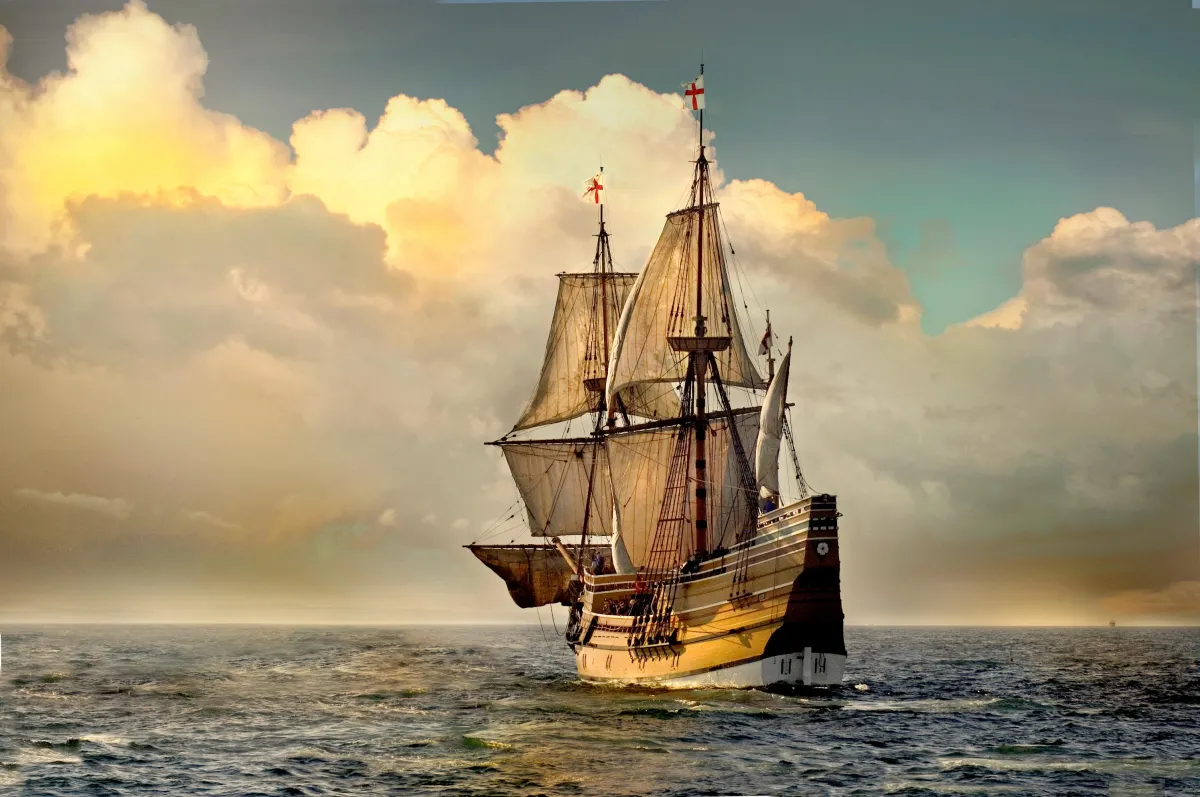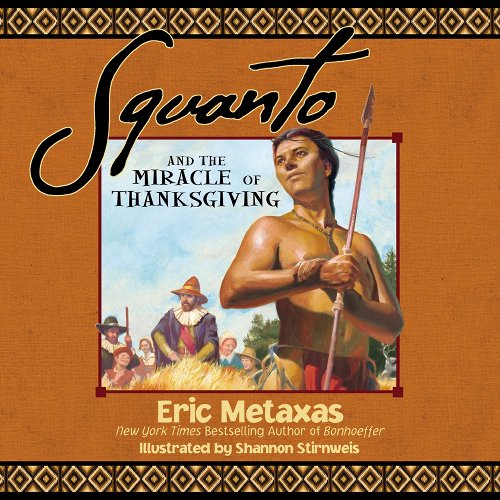Articles
Exploring History's Greatest Adventures throughout time!


The Real Story of the Mayflower Pilgrims and The First Thanksgiving
You've probably heard stories about the first Thanksgiving - you know, Pilgrims and Native Americans coming together for a grand feast. You may even have heard that the stories passed down for centuries might be worth a bit of myth-busting. Join me on a journey through time as we explore the real deal behind the first Thanksgiving and how it fits into the grand tapestry of big events in American history.
Once upon a time, in the early 1600s, there was a group of people from England who wanted to have religious freedom. They were called the Pilgrims because they were on a religious journey. They decided to leave England and go to the “New World” in America in search of a better life.
These brave Pilgrims sailed on a big ship called the Mayflower in September 1620. They faced many challenges during their long journey across the Atlantic Ocean. Imagine being on a ship for two months with nothing to do but worry if you’ll make it! It wasn't easy.
Finally, in November 1620, the Mayflower reached a place that is now part of Massachusetts. It was cold, and the Pilgrims were so happy to step onto land after their long, tough journey. They called this place Plymouth, and that's where our story begins.
The Pilgrims were excited to start their new Plymouth colony, but they had a problem. They didn't know much about the land they had arrived in. They didn't know how to find food, build houses, or survive in this new place.
Luckily, they had some help from a group of people who had been living in America for a very long time. These people were native to the Americas. They were called Wampanoag. They had their own communities and had been living off the land for thousands of years.
The Pilgrims didn't know if the Wampanoag would be friendly or not. They had heard stories of Native Americans, and they were worried about how they would be received.
The Wampanoag had enountered big ships before, so they were a little wary of the newcomers. But they displayed kindness and chose to help them.
One of the Wampanoag who played a big role in helping the Pilgrims was a man named Squanto. He had been kidnapped and taken to England in the past, but he had managed to return to his homeland. Squanto could speak English, which was very helpful for the Pilgrims because they could communicate with him. (See Suggested Reading below to learn more about Squanto.)
Squanto taught the Pilgrims many important things, like how to grow corn, how to catch fish, and where to find edible plants. He also helped them build homes and showed them how to survive in the new land.
In November 1621, after a year of hard work, the Pilgrims had their first successful corn harvest. They were so grateful for their bountiful harvest that they decided to have a big feast to give thanks.
The Pilgrims invited Squanto and the Wampanoags to join them in this feast as thanks for their help. The guests also brought some of their own food to share. Together, they had a big celebration, with lots of delicious food, games, and music. It was a time of friendship and gratitude for the help they had received. This feast is now known as the First Thanksgiving.
The First Thanksgiving is an important part of American history. It reminds us of the importance of friendship, cooperation, and being thankful for what we have.
But we also have to remember that not all interactions between the Pilgrims and Native Americans were as peaceful as the First Thanksgiving. In the years that followed, there were conflicts and difficult times between the Europeans and native Americans. It's essential to learn from these events and work toward a better understanding and cooperation between different cultures and communities.
So the story of the Mayflower Pilgrims and their first encounter with Native Americans is a story of bravery, friendship, and the importance of working together. It's a story that teaches us to be thankful for the help we receive and to treat others with kindness and respect, no matter where they come from.
As you celebrate Thanksgiving and learn about this part of history, remember the lessons from the Pilgrims and the Native Americans. They show us the power of friendship and cooperation, and they remind us to be grateful for all the good things in our lives.
Myths Busted!
Myth #1: Turkey, Pumpkin Pie, and Mashed Potatoes – Oh My!
Sure, we all love turkey, cranberry sauce, and pumpkin pie on Thanksgiving, but the Pilgrims' feast was quite different. It featured venison, seafood, and various vegetables. But, it's not entirely clear if turkey was on the menu. It may have been, though, since the bird was described in journals as plentiful, along with water fowl, pigeons, partridges, and quail. With nearly 150 people to feed, they likely had it all.
What makes America truly special is its diverse cultural landscape. Thanksgiving has evolved to be inclusive of all many traditions. It's not just about Pilgrims and the Wampanoag people, but also about the generations of immigrants who have added their own flavors to the feast.
Whether it's tamales alongside the turkey, samosas next to the stuffing, or sushi rolls on the side, Thanksgiving has become a celebration of cultural diversity. It's a testament to the ever-evolving nature of the United States and how the first Thanksgiving set the stage for a big, inclusive tapestry of traditions.
Myth #2: The first Thanksgiving took place on the fourth Thursday of November, 1621.
Besides the year, no one knows the actual date of the first Thanksgiving. We know it was a three-day event that started on a Thursday, but no one mentioned the actual date when they wrote about it. The harvest feast that brought together 53 Pilgrims and some 90 Native Americans occurred some time in the fall of 1621, which could have been any time from September through November.
As an immediate tradition, the repeat celebration lasted a few years starting November 25, 1668. George Washington made Thursday, November 26, a public day of thanksgiving in 1789. After that, it was sometimes celebrated on different dates, but no standard.
Finally, President Abraham Lincoln established Thanksgiving as a national holiday in 1863 to fall on the last Thursday of November. It was his way of unifying the country during the American Civil War and fostering a spirit of gratitude. But President Franklin Roosevelt changed it to the fourth Thursday in November. He wanted to extend the holiday shopping season and help the economy during the Great Depression.
So, the date of Thanksgiving has gone through a few changes over time, but it's still a special day to show gratitude and spend time with family and friends.
Historical Accounts of the First Thanksgiving
The Primary Source: William Bradford's Journal
To get the inside scoop on the first Thanksgiving, we turn to none other than William Bradford, a Pilgrim who kept a journal of their experiences. He wrote about the harsh challenges they faced when they first arrived in Plymouth, including disease, hunger, and harsh weather.
In his journal, Bradford described their successful harvest and the bounty of fruits, vegetables, fish, and fowl. “Besides, they had about a peck a meal a week to a person, or now since harvest, Indian corn to the proportion. Which made many afterwards write so largely of their plenty here to their friends in England, which were not feigned but true reports."
Edward Winslow's Letter: A Firsthand Account
Imagine you're a Pilgrim, and you want to share the story of the first Thanksgiving with folks back in England. That's precisely what Edward Winslow did. He wrote a letter to a friend in England, describing their experiences:
“At which time, amongst other recreations, we exercised our arms, many of the Indians coming amongst us, and among the rest their greatest king Massasoit, with some ninety men, whom for three days we entertained and feasted…”.
The Lost Accounts: Missing Pieces of the Puzzle
While we have primary sources like Bradford's journal and Winslow's letter, some details about the first Thanksgiving remain a mystery. There are no known records to tell the story from the Wampanoag’s side.
Their perspective on the feast and their experiences would undoubtedly add depth to our understanding of the first Thanksgiving. So, as we explore the historical accounts, keep in mind that there are still some missing pieces in the puzzle of this big event in American history.
Gathering of Hearts: A Time to Reconnect
Thanksgiving is not just about the feast but also a time for families to reunite, friends to catch up, and communities to bond. This sense of connection and reconnection is what makes Thanksgiving special.
The first Thanksgiving was a gathering of hearts, a coming together in a time of need. This spirit of unity has carried through history, from the founding of the nation to modern times. It's a reminder that, amid all the big events in American history, people have always found ways to reconnect and celebrate together.
Thanksgiving isn't just a historical event from the past; it's a vital piece of the larger puzzle that is American history. It's a reminder that moments of unity, gratitude, and coming together have shaped the nation's story from the beginning. So, as you celebrate this Thanksgiving, remember the threads that connect you to those early gatherings. Happy Thanksgiving!
Recommended Reading

Squanto and the Miracle of Thanksgiving: A Harvest Story from Colonial America of How One Native American's Friendship Saved the Pilgrims by Eric Metaxas
(Picture book for Ages 5 to 9.)
In 1608, traders came to Massachusetts, captured a Patuxet boy named Squanto, and sold him into slavery. He was later cared for by Christians, taught faith in God, and learned to speak English. Ten years after his capture, he returned to America. When the Pilgrims arrived at Plymouth Rock, imagine their surprise to find an indigenous man who spoke the same language as they did. Because of Squanto's help translating, the Pilgrims and the Native Americans lived together in friendship and celebrated the first Thanksgiving.

If You Were a Kid on the Mayflower (If You Were a Kid series) by John Son
(Picture book for ages 7 to 9)
In 1620, a group of Pilgrims left Europe aboard a ship called the Mayflower. They sailed toward North America, hoping to make a new home where they could practice their religion freely. Join young passengers, Hope and Theodore, as their set sail on a 66-day journey across the Atlantic Ocean.
History Smashers: The Mayflower (History Smashers series) by Kate Messner (Ages 8 to 12)
Did you know that the pilgrims didn't go straight from England to Plymouth? No, they made a stop along the way--and almost stayed forever! Did you know there was a second ship, called the Speedwell, that was too leaky to make the trip? No joke. And just wait until you learn the truth about Plymouth Rock. Through illustrations, graphic panels, photographs, sidebars, and more, kids can explore the little-known details behind the legends of the Mayflower and the first Thanksgiving.
Squanto: The Life and Legacy of the Patuxet Native Who Saved the Pilgrims of the Mayflower by Charles River Editors
The story of a man who, in spite of a lifetime of hardship and mistreatment, nonetheless had the strength of character to look past skin color and help a small group of starving English families survive their first winter in the “New World.”
Activities
The First Thanksgiving Word Search Puzzle
Find words and phrases used in this article. Download the Word Search now FREE from Historic Books for Kids.
© 2023. Historic Books for Kids - All Rights Reserved
Reading Pennsylvania, USA
